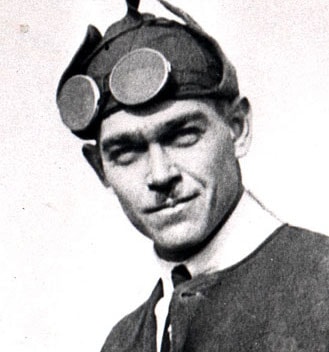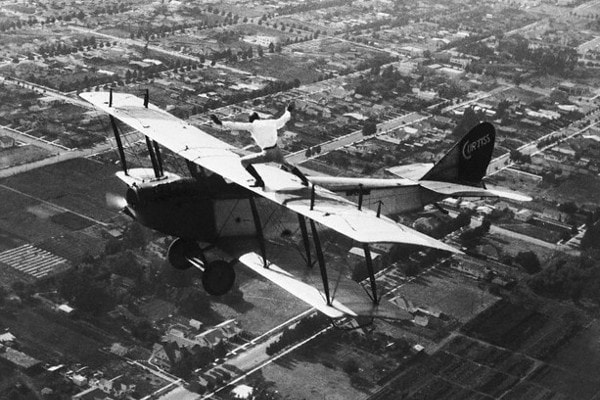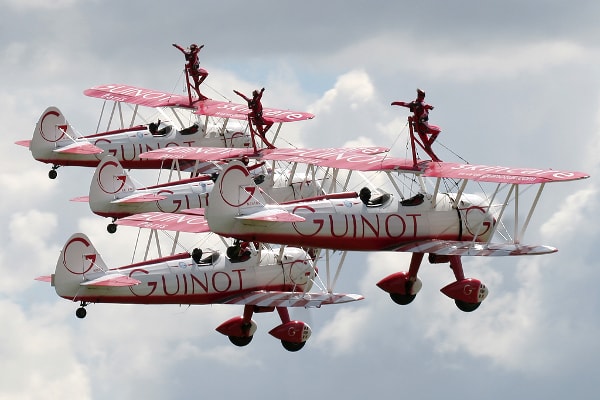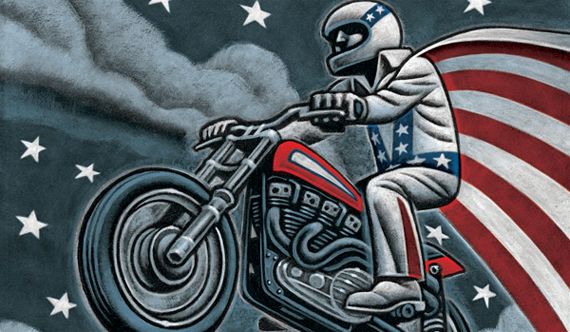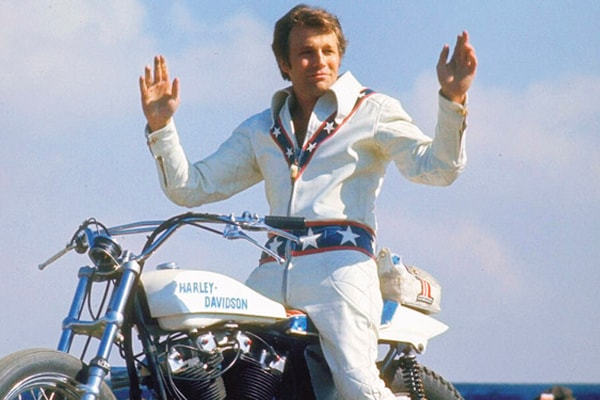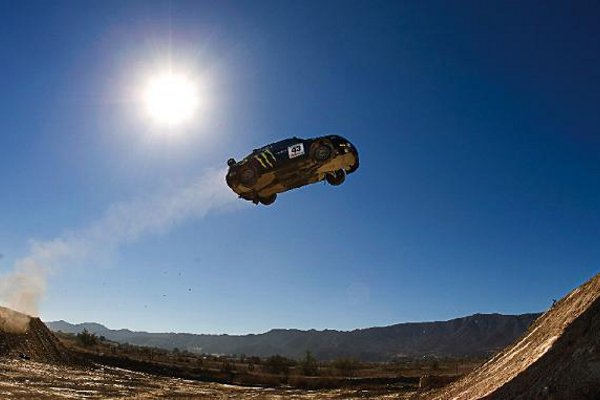Most of today's dictionaries describe the daredevil as being a reckless, impetuous and irresponsible person, one who pursues actions so risky it may kill them. But, as we're sure you already know, being a daredevil means much more than that, mostly because of the exploits of a handful of individuals who took their bodies and machines to their limits.
With most of the daredevils going down in history as possible basket cases, it's no wonder people tried to put some reason behind their crazy actions. Some blame it on the need for adrenaline, others on the public's craving for unusual stars and if Freud was around, we're pretty sure he'd say daredevils had been abused by their mothers...
PREVIEW
Regardless of why daredevils do what they do, they have become a constant presence once the technology was evolved enough to help them in their endeavors. In the early beginnings, daredevils where to be seen mostly in circus shows, where they performed as human cannonballs, tightrope or high-wire walkers and so on.
This type of circus daredevil was however eclipsed after the First World War. The stars of the war, pilots, or aces, as they have come to be known, having experienced the beauty of flight and the terror of dog fights, were at the center of this new trend.
Given the lack of an enemy to shoot at and the appetite for air shows the public was displaying, aces of the first World War took to the skies to perform races and, even more, dangerous air maneuvers.
As the excitement caused by seeing a guy or two flying inside an aircraft became obsolete, Locklear thought he could try flying outside the aircraft. And so he did.
According to reports, Locklear, who had already performed out-of-the-plane wing walks during his pilot training in the Army Air Service as a means to fix issues with the airplanes, first performed in front of an audience on November 8, 1918 at Barron Field, Texas. His wing walking skills pleased the crowds much more than the already obsolete barnstorming air shows.
The motivation for the daredevils to follow on Locklear's footsteps was as simple as it was straightforward: make money, and lots of them. Wing walkers themselves were apparently quite keen on one of them dying, if that would mean more people coming to their shows. "Don't ever forget that we're both capitalizing on the chance of your sudden death," events promoters used to say.
At the time, Locklear was perceived as the father of aviation acrobatics, being largely responsible for creating the basis for all the maneuvers performed since, be it handstands or hanging postures. Locklear was the first person to switch from one plane to another while in mid-air.
The growing interest in wing walking and other out-of-the-plane stunts attracted so many young people to the “job” that by 1919, only a few months after it all started, at least eight wing walkers were dead.
That death toll did not include Ormer Locklear, who passed away in 1920, together with his colleague, Milton Elliott. Elliott's plane had to dive, with Locklear on the outside, towards oil derricks and create the illusion they are about to crash.
Instructions for the ground crew were that when the plane got near, the ground crew were to douse their lights, signaling Elliott to pull out of the dive. The crew however left the lights running and the plane crashed. The crash happened while the two were filming Locklear's second movie, The Skywayman.
In 1939, the US banned wing walking below 1,500 feet (457 meters). Since the entire show of wing walking stunts had been created for the public to view, sending the airplanes and the daredevils beyond the comfortable field of view of the crowds meant the sports was slowly coming to its end.
The icon of the daredevil term is, as you probably know, Robert Craig Knievel, known to the screaming crowds as Evel. Born into this world at about the time wing walking began dying, in 1938, Knievel shortly became the quintessential daredevil.
His career begun in the most unlikely place, as a diamond drill operator for the Anaconda Mining Company. Being probably bored with his job, Knievel decided to do a type of wheelie using the earth mover he was operating. The feat itself wouldn't have been noticed hadn't it cause his home city of Butte, Montana to be out of power for several hours, after the mover hit the city's main power line.
After several years of working various more or less legal jobs and even owning a Honda motorcycle dealership in Moses Lake, Knievel decided to set up his own motorcycle road show, inspired by the Joie Chitwood show he saw at the age of eight. His first documented jump, in front of a very small crowd, took him some 20 feet (6 meters) over a bunch of boxes.
Knievel's career took off at Caesar's Palace, Las Vegas, in 1967. The daredevil used all his skills as a law breaker to lie and cheat his way into making the hotel agree with him jumping a motorcycle over the fountains at Caesars Palace.
The jump ended in disaster, as Knievel suffered a crushed pelvis and femur, fractures to his hip, wrist and both ankles and ultimately a 29-day coma. Luckily for him, Knievel had arranged for the entire stunt to be filmed. ABC-TV bought the rights to the film after he recovered, opening the flood gates for more jumps and broken records and bones.
For the better part of his career, Knievel crashed more than he successfully jumped, but it was exactly this which brought him success. In Evel's case, it was not the success of the act that mattered, but him trying. For the crowds, it was like watching the wing walkers of the 1920s. Making a jump was exciting enough, sure, but seeing Knievel squashed and thrown around like a dummy was far more entertaining.
During his career, Knievel broke his collarbone, fractured his arms and legs, broken his back and pelvis and has been in a coma. Yet, it was none of these injuries which got to him, but the less spectacular diabetes and an incurable lung condition. Knievel died in 2007. He is survived by a huge popular culture created around him.
But this doesn't mean nobody is trying.
Perhaps the most famous individual trying to make a name for himself in this business is Ken Block. Currently Ford Rally America and WRC driver, Block is an active participant in the X Games and the inventor of the Gymkhana-style videos.
Yet, despite his endeavors being spectacular, they are not, sorry to say, life threatening. And it is exactly this element which stands at the basis of a successful daredevil.
Although most consider daredevils reckless, that's hardly the case. Most of them have some type of training behind them, whether it comes in the form of Block's experience or Knievel's trial and error approach.
This type of circus daredevil was however eclipsed after the First World War. The stars of the war, pilots, or aces, as they have come to be known, having experienced the beauty of flight and the terror of dog fights, were at the center of this new trend.
Given the lack of an enemy to shoot at and the appetite for air shows the public was displaying, aces of the first World War took to the skies to perform races and, even more, dangerous air maneuvers.
AIRPLANE DAREDEVILS
Of course, flying around in a plane and twisting it upside down and sideways was to become soon too boring for the danger-craving audiences. This is why Ormer Locklear, a carpenter/mechanic from Greenville, Texas, decided to take flying to a whole new level.As the excitement caused by seeing a guy or two flying inside an aircraft became obsolete, Locklear thought he could try flying outside the aircraft. And so he did.
According to reports, Locklear, who had already performed out-of-the-plane wing walks during his pilot training in the Army Air Service as a means to fix issues with the airplanes, first performed in front of an audience on November 8, 1918 at Barron Field, Texas. His wing walking skills pleased the crowds much more than the already obsolete barnstorming air shows.
The motivation for the daredevils to follow on Locklear's footsteps was as simple as it was straightforward: make money, and lots of them. Wing walkers themselves were apparently quite keen on one of them dying, if that would mean more people coming to their shows. "Don't ever forget that we're both capitalizing on the chance of your sudden death," events promoters used to say.
At the time, Locklear was perceived as the father of aviation acrobatics, being largely responsible for creating the basis for all the maneuvers performed since, be it handstands or hanging postures. Locklear was the first person to switch from one plane to another while in mid-air.
The growing interest in wing walking and other out-of-the-plane stunts attracted so many young people to the “job” that by 1919, only a few months after it all started, at least eight wing walkers were dead.
That death toll did not include Ormer Locklear, who passed away in 1920, together with his colleague, Milton Elliott. Elliott's plane had to dive, with Locklear on the outside, towards oil derricks and create the illusion they are about to crash.
Instructions for the ground crew were that when the plane got near, the ground crew were to douse their lights, signaling Elliott to pull out of the dive. The crew however left the lights running and the plane crashed. The crash happened while the two were filming Locklear's second movie, The Skywayman.
In 1939, the US banned wing walking below 1,500 feet (457 meters). Since the entire show of wing walking stunts had been created for the public to view, sending the airplanes and the daredevils beyond the comfortable field of view of the crowds meant the sports was slowly coming to its end.
MOTORCYCLE DAREDEVILS
Perhaps the most famous daredevils are the ones performing their death defying acts by means of bikes. Since the advent of the motorcycle, this piece of technology has been put through its paces more than any other, in all types of competitions designed to test their limits. In no other case however have bikes been tortured more than in the hands of the daredevils.The icon of the daredevil term is, as you probably know, Robert Craig Knievel, known to the screaming crowds as Evel. Born into this world at about the time wing walking began dying, in 1938, Knievel shortly became the quintessential daredevil.
His career begun in the most unlikely place, as a diamond drill operator for the Anaconda Mining Company. Being probably bored with his job, Knievel decided to do a type of wheelie using the earth mover he was operating. The feat itself wouldn't have been noticed hadn't it cause his home city of Butte, Montana to be out of power for several hours, after the mover hit the city's main power line.
After several years of working various more or less legal jobs and even owning a Honda motorcycle dealership in Moses Lake, Knievel decided to set up his own motorcycle road show, inspired by the Joie Chitwood show he saw at the age of eight. His first documented jump, in front of a very small crowd, took him some 20 feet (6 meters) over a bunch of boxes.
Knievel's career took off at Caesar's Palace, Las Vegas, in 1967. The daredevil used all his skills as a law breaker to lie and cheat his way into making the hotel agree with him jumping a motorcycle over the fountains at Caesars Palace.
The jump ended in disaster, as Knievel suffered a crushed pelvis and femur, fractures to his hip, wrist and both ankles and ultimately a 29-day coma. Luckily for him, Knievel had arranged for the entire stunt to be filmed. ABC-TV bought the rights to the film after he recovered, opening the flood gates for more jumps and broken records and bones.
For the better part of his career, Knievel crashed more than he successfully jumped, but it was exactly this which brought him success. In Evel's case, it was not the success of the act that mattered, but him trying. For the crowds, it was like watching the wing walkers of the 1920s. Making a jump was exciting enough, sure, but seeing Knievel squashed and thrown around like a dummy was far more entertaining.
During his career, Knievel broke his collarbone, fractured his arms and legs, broken his back and pelvis and has been in a coma. Yet, it was none of these injuries which got to him, but the less spectacular diabetes and an incurable lung condition. Knievel died in 2007. He is survived by a huge popular culture created around him.
CAR DAREDEVILS
Unfortunately for the automotive industry, cars seem to have better luck at entering competitions than to be used as tools of the trade by daredevils. To date, there is not a single person worth mentioning as a car-daredevil. Even more, a car greatly limits the options at hand for wannabe daredevils, as the stunts are pretty much length-based and lack the variety of choices available for airplanes and bikes.But this doesn't mean nobody is trying.
Perhaps the most famous individual trying to make a name for himself in this business is Ken Block. Currently Ford Rally America and WRC driver, Block is an active participant in the X Games and the inventor of the Gymkhana-style videos.
Yet, despite his endeavors being spectacular, they are not, sorry to say, life threatening. And it is exactly this element which stands at the basis of a successful daredevil.
Although most consider daredevils reckless, that's hardly the case. Most of them have some type of training behind them, whether it comes in the form of Block's experience or Knievel's trial and error approach.
